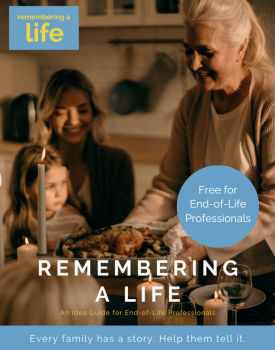
After a Death Occurs Checklist
The death of a loved one and planning a funeral or memorial can be emotionally and physically exhausting. It's also something most of us only experience a few times in our lives. Therefore, many aren't aware of the steps that need to be taken after a death. The checklist below takes you, step-by-step, through the process. Use it to help ensure you are taking care of all the necessary details so you can concentrate on providing a beautiful life tribute for your loved one.Download When a Death Occurs Checklist
At Time of Death
Step 1: Contact the appropriate party:- If the death occurred at a hospital or while on hospice, speak with the staff regarding when the funeral director should be contacted and who is responsible to do so (family or staff).
- If the death was unanticipated and did not occur at a hospital, call 911 to go through the appropriate emergency procedures.
Step 2: Connect with the funeral home (if not already done); they may have some basic questions that will better prepare them to receive and transport the deceased. They will also want to schedule a time to make funeral arrangements.
Step 3. Notify friends and family. Make arrangements for any dependents or pets and/or tend to the person's home, if applicable (collect mail, water plants, clean out refrigerator, etc.). Notify church and clergy (this can also be done once arrangements have been made).
Step 4: If not already discussed, begin to talk with close family and friends about the type of service or memorial that would best honor your loved one's life. Discuss how youth and children in the family might be able to play a role in honoring their loved one at the service. This is also a good time to write down any questions or concerns you might have for the funeral director. Taking notes throughout the process can provide some peace of mind that items have been addressed and taken care of based on the family's wishes.
At the Arrangement
- Locate any important paperwork related to the deceased's funeral plans, insurance policies, bank accounts, will, military discharge papers, etc.
- Select a photo that might be used in the obituary or to help the funeral home prepare your loved one for viewing.
- Gather any clothing or jewelry you would like your loved one to be wearing for the service (or visitation/burial), if applicable.
- Gather necessary biographical information (social security number, date and place of birth, parents' full names, including maiden names, etc.).
- Gather any other information or photos that might be used for an obituary or memorial video.
- When you meet with your funeral director, he or she many ask you to bring some required documentation to the meeting. You'll discuss all the details of the service (as applicable), including the date, time, venue, type of service, officiants, music and reception plans. You'll also discuss burial and cremation options and make casket or urn selections. Your funeral director will help coordinate all funeral plans, handle securing the death certificate, write and submit death notices and obituaries as needed and help with any other concerns that pertain to services for your loved one.
Other steps your funeral director can guide you through include:
- Contacting the individual's employer, if applicable (even if individual was retired), to discuss life insurance benefits, compensation, pension and other benefits.
- Contacting life insurance companies to discuss benefits and request claim forms. Update your own life insurance beneficiaries if necessary.
- Contacting service clubs, alumni associations, veterans' and other membership associations to notify them of the death.
- Setting up any memorial funds.
Days Before Service
- Gather photos and mementos to display at the service. If you are unsure of what is appropriate, your funeral director may be able to provide guidance.
- Ensure loved ones who were close to the deceased have been notified of the death.
Day of the Service
Your funeral director will take care of all arrangements on the day of the service, including arranging displays of photos and/or mementos, putting out service programs, greeting guests, managing the order of service, etc.
Within Ten Days of Death
- If not done already, receive death certificates from the funeral home. Many of the following actions will require a death certificate.
- Take the will to the appropriate county or city office to have it accepted for probate.
- If necessary, the estate’s executor should open a bank account for the deceased’s estate.
- Download the 'Organizations to Contact After a Death' Checklist for additional contacts and organizations to notify.
- Download the complete form and checklist for notifying Credit Reporting Agencies as well.
As Time Permits Following the Service
- Send thank-you notes to individuals who attended the service, participated in the service, contributed funds in memory of the loved one, sent flowers, etc.
- Continue to gather with family and friends to reflect on your loved one.
- Contact the Direct Marketing Association to add the decedent's name to the Deceased Do Not Call List. All members of the DMA will delete the decedent's name from their mailing lists for a fee of $1. Visit. ims-dm.com/cgi.ddnc to learn more.
Notifying Social Media Sites
See instructions below for notifying several of the most popular social media sites of a death. Since these websites provide various options, it is always advisable to visit the website and determine what course of action may be best. For example, with Facebook, there are three options upon a report of a death. The first would be to permanently delete the decedent’s account. A second option is to “memorialize” the account which allows Facebook friends of the decedent to view the profile and post memorial messages. The final option is available if the decedent, during his or her lifetime, designated a Legacy Contact. The individual who had been designated as the Legacy Contact would be able to post to the profile to share funeral information and to extend appreciations.
Download the complete checklist for notifying Social Media Sites
Throughout the Process and Beyond
As hard as it may be to remember, self-care is critical. Make sure you and those close to you take time for yourselves. Take breaks while taking care of the things above and as needed. Reflect on the life of your loved one, but also do things that will help you relax, whether you take a walk, go for a swim, or enjoy a meal with friends. Remember that grief knows no timeline. It takes time to adjust and heal. If you find yourself struggling, it is OK to ask for help. Your funeral director can be a great source of information and support.
